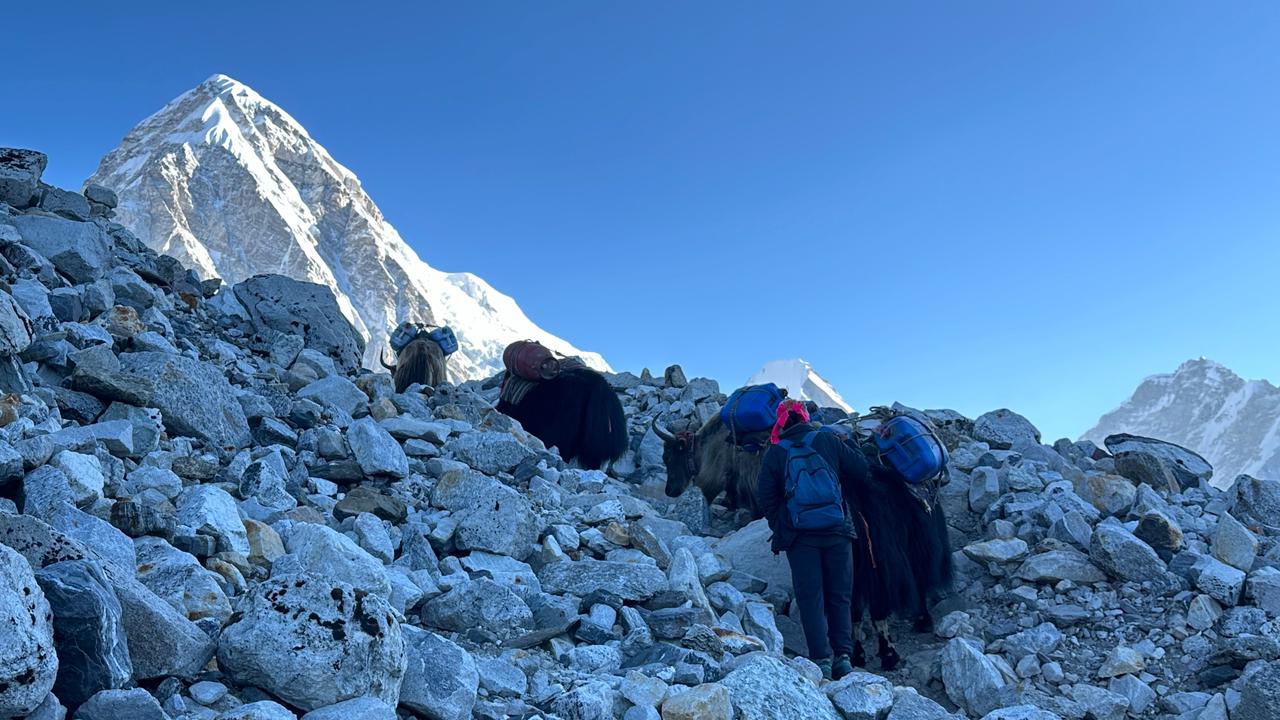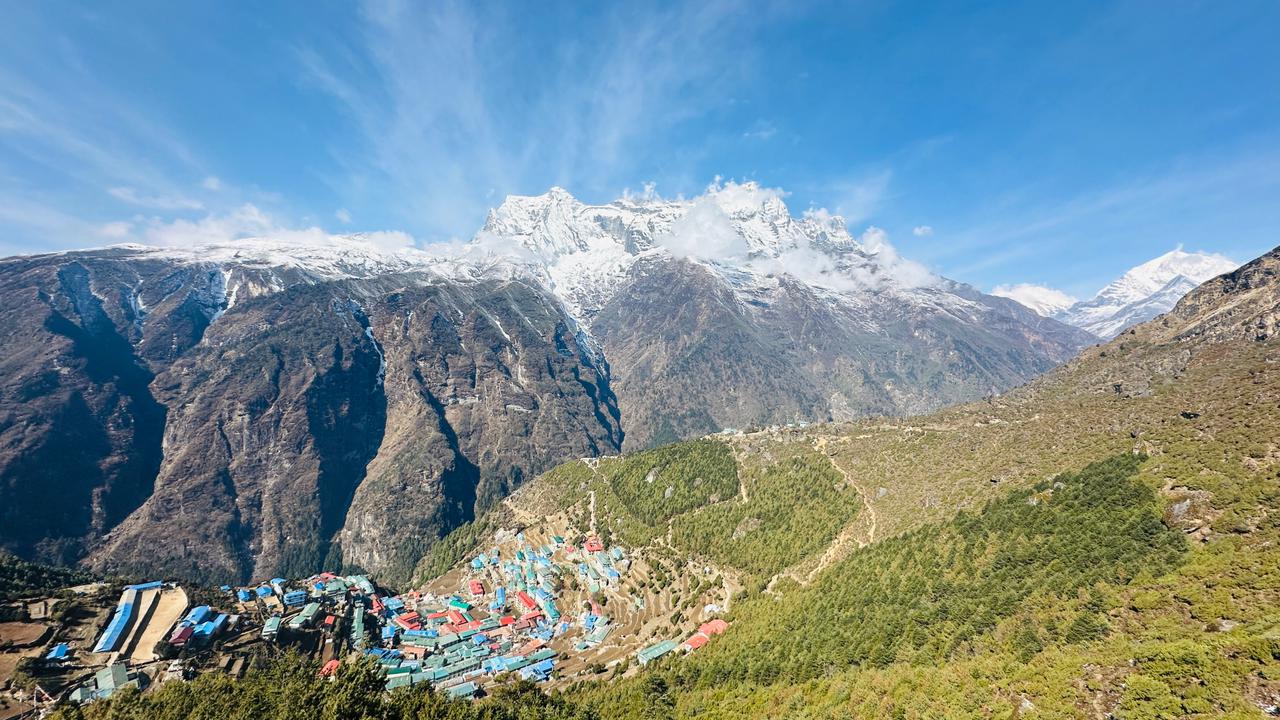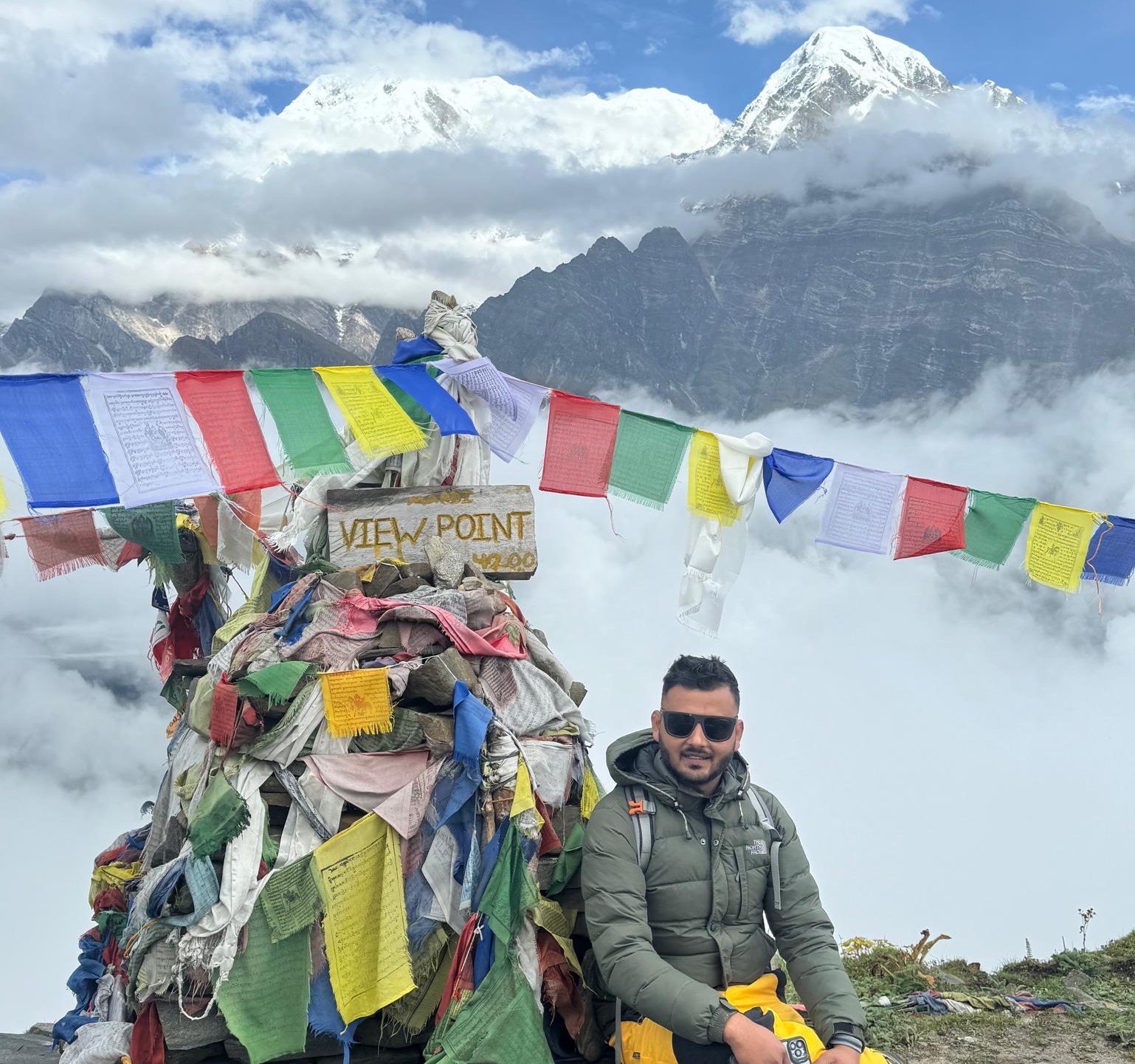
The Everest Base Camp Trek guide offers all the information of adventurers an unparalleled journey through the heart of the Himalayas where they traverse the scenic Khumbu Valley and encounter four of the world’s six highest peak. This trek is not just a physical challenge; it’s a passage through history, following the legendary path Sir Edmund Hillary and Tenzing Norgay took to conquer Everest, and a cultural immersion in the life of high-altitude Sherpa village. The allure of trekking to Everest Base Camp lies in its blend of natural beauty, from breathtaking vistas at Kala Patthar to the cultural richness found in Namche Bazaar, making it a coveted adventure for thrill-seekers globally.
During the 12-day Everest base camp trek itinerary from Lukla, trekkers face the dual challenges of rugged terrain and high altitudes, with Everest Base Camp. EBC is sitting at 5600m and parts of the journey requiring acclimatization above 5000. Despite these challenges, the trek remains accessible, attracting a broad spectrum of hikers drawn by the Everest Base Camp Trek cost. The experience of flying into the dramatic Lukla airport, and the guidance of experienced Sherpa guides. The trek offers more than just stunning landscapes; it’s a journey that tests the limits of the human spirit and fosters a deep connection with the natural and cultural splendor of Nepal.

Table of Contents
Trek outline Itinerary
12 days Everest base camp trek itinerary is suggested for hikers. Here is outline itinerary below.
| Day | Itinerary | Elevation (M) | Trek hour |
| 1 | Fly from Kathmandu to Lukla and Trek to Phakding (30 min flight) | 2651m | 2-3 hrs |
| 2 | Trek from Phakding to Namche Bazaar | 3440m | 5-6 hrs |
| 3 | Side trip and rest day in Namche Bazaar | 3440m | 3-4 hrs |
| 4 | Trek from Namche Bazaar to Tengboche | 3860m | 5-6 hrs |
| 5 | Trek from Tengboche to Dingboche | 4343m | 5-6 hrs |
| 6 | Acclimatization Day – Dingboche | 4343m | 3-4 hrs |
| 7 | Trek from Dingboche to Lobuche | 4950m | 5-6 hrs |
| 8 | Trek from Lobuche to Everest Base Camp, then back to Gorak Shep | 5370m | 6-7 hrs |
| 9 | Morning hike up to Kala Patthar(5643M) and trek from Gorak Shep to Pheriche | 4371m | 7-8 hrs |
| 10 | Trek from Pheriche to Namche Bazaar | 3440m | 6-7 hrs |
| 11 | Trek from Namche Bazaar to Lukla | 2800m | 6-7 hrs |
| 12 | Fly back from Kathmandu to Lukla | 1300m | 30 min |
Best Time to Trek
Everest Base Camp Trek can be taken off upon at various times of the year, each offering distinct experiences depending on the season. Here’s a detailed breakdown:
Pre-Monsoon Season (February to May)
- Late February to Early March: Trekkers enjoy clear skies and crisp air, providing spectacular views of the mountainous landscape.
- March: The arrival of spring brings warmer temperatures and melting snow, making the paths more accessible.
- April: This month sees the highest number of trekkers, resulting in crowded trails and fully occupied teahouses.
- May: Weather begins to turn wetter with frequent afternoon rains and snow, which can add a layer of challenge to the trek.
Post-Monsoon Season (Late September to November)
- General Conditions: The skies clear up, offering less haze and more stunning views of the peaks.
- Temperature and Terrain: Although colder, this season is favorable for hiking to attractions like the Gokyo Lakes.
- Crowd Levels: Similar to the pre-monsoon season, the trails and teahouses tend to be quite busy.
Off-Peak Seasons
- Winter (December to February): Trekking is possible but challenging due to very low temperatures (down to -30°C at night) and potential snow closures of passes.
- Monsoon (June to September): Characterized by warm weather but heavy rainfall, making the trails muddy and less suitable for trekking.
For those, who planning their trek, the optimal times are during the stable and, dry conditions of spring (March to May) and the clear, mild weather of autumn (September to November). These periods not only offer the best weather conditions but also vibrant natural scenery, although they can also be the most crowded.

Everest Base Camp Trek Highlights
EBC trekking is a once-in-a-lifetime adventure that offers breathtaking views, unique cultural experiences, and a sense of accomplishment like no other. Here are some of the highlights of this iconic trek.
Stunning Scenery
- Mount Everest: The trek offers unparalleled views of the world’s highest peak, Mount Everest, standing at 8,848 meters. Witnessing the awe-inspiring sight of this majestic mountain up close is an experience that remains etched in the memory forever.
- Khumbu Icefall: This treacherous yet captivating icefall is a major highlight of the trek. The towering ice pinnacles and deep crevasses create a mesmerizing yet challenging terrain for trekkers.
- Sagarmatha National Park: The trek takes you through the Sagarmatha National Park, a UNESCO World Heritage site, renowned for its diverse flora and fauna, including rare species like the snow leopard and red panda.
Unique Sherpa Culture
- Tengboche Monastery: This ancient monastery, with its ornate architecture and serene surroundings, provides a glimpse into the spiritual heart of the Sherpa people. Visitors can witness the daily rituals and prayers performed by the resident monks.
- Sherpa Villages: Along the trail, trekkers encounter traditional Sherpa villages like Namche Bazaar and Khumjung. Trekkers can immerse themselves in the warm hospitality and rich culture of the Sherpa community.
Challenging Yet Rewarding Trekking Experience
- High-Altitude Challenge: The trek presents various challenges, including high altitude, rugged terrain, and unpredictable weather. Overcoming these obstacles and reaching Everest Base Camp at an altitude of 5,364 meters is an immensely rewarding achievement.
- Panoramic Views: Throughout the trek, trekkers are treated to panoramic vistas of other Himalayan giants. Such as Lhotse, Nuptse, and Ama Dablam, offering ample opportunities for stunning photographs and moments of awe.
Camaraderie and Adventure
- Fellow Trekkers: The trail to Everest Base Camp attracts adventurers from all over the world, fostering a sense of camaraderie and shared experiences. The interactions with fellow trekkers and locals create a vibrant and memorable journey.
- Adventure of a Lifetime: From crossing suspension bridges adorned with prayer flags to staying in cozy teahouses nestled in the mountains, every moment of the trek is an adventure waiting to be embraced.
In conclusion, the Everest Base Camp trek is not just a physical journey. the trek also a deeply enriching and awe-inspiring experience that leaves an indelible mark on all who undertake it. The combination of natural beauty, cultural immersion, and personal achievement makes it a truly unparalleled adventure.
Required permit and Permit cost
To Jump on the Everest Base Camp Trekking, trekkers must secure several mandatory permits. The Permits ensure both the regulation of tourism and the conservation of the region’s unique environment. However, here’s a detailed overview of the necessary permits and their costs:
Sagarmatha National Park Entry Permit
- Cost for Foreign Nationals: NPR 3,000 per person
- Cost for SAARC Nationals: NPR 1,500 per person
- Cost for Nepalese Nationals: NPR 100 per person
Where to Obtain: Nepal Tourism Board Office in Kathmandu or at the entry gate in Monjo.
Khumbu Pasang Lhamu Rural Municipality Entrance Permit
- Cost: NPR 2,000 per person for up to four weeks, and NPR 2,500 for extended stays beyond four weeks
Where to Obtain: Can be acquired either in Lukla upon arrival or at Monjo
It is important for trekkers to note that the TIMS permit, previously a requirement, is no longer necessary for the Everest Base Camp trek. All permits can be conveniently purchased along the trail, allowing trekkers to manage their documentation as they progress through their journey.
Everest Base Camp Trekking Costs
The financial planning for the Everest Base Camp Trekking varies widely based on several factors. It depends on the choice of route, the trekking company employed, and the level of comfort desired during the journey. The overall cost for the trek can range from $1300 to $4000. This includes various components like travel, accommodation, meals, and guide services. Here’s a breakdown of the key expenses:
Accommodation and Meals
- Kathmandu Hotels: Prices per night range from $10 for basic lodging to $450 for luxury accommodations.
- Teahouses on the Trek: A bed per night costs about $5 at lower elevations, rising to $15 at Gorak Shep, the final stop before reaching the base camp.
- Meals: The meals prices starts at per meal $10 and can go up to $20 in higher altitude areas like Gorak Shep.
Transportation and Guides
- Flights: Round trip flights from Kathmandu to Lukla, the gateway to Everest, cost between $380 and $400
- Transport: Both international airport pick up and drop off, cost between $50 and $100
- Guide and Porter Fees: Daily rates for a guide range from $35, and for a porter, it’s from $25
Additional Costs
- Travel Insurance: Essential for covering high-altitude trekking up to 6000m, typically priced around $160 for 30 days.
- Trekking Gear: Initial costs for basic equipment range from $150 to $500, necessary for beginner trekkers.
- Miscellaneous Expenses: These can include personal expenses and tips, adding an additional $150 to $300 to the budget.
Understanding these costs helps trekkers budget effectively, ensuring a well-prepared and enjoyable journey to Everest Base Camp. However, Royal holidays Adventure offers 12 days Everest base camp trekking in this cost with mentioned services for 2025.
| Number of pax | Cost in USD ($) | Book your trek |
| 1 person | 1100 | Send Inquiry |
| 2-4 people | 950 | |
| 5-10 people | 850 |
Trek Difficulty
The Everest Base Camp Trek is a challenging adventure that requires a good level of physical fitness and determination. This trek spans approximately 130 km round trip, covering about 15 km per day, with daily trekking hours ranging from nearly 6 to 7.5 hours. Moreover, the journey begins at an altitude of 2,950m in Lukla and reaches up to 5,400m at Everest Base Camp. it is presenting a significant challenge due to the high altitude and rugged terrain.
-
Altitude Challenges and Health Risks
The most daunting aspect of the Everest Base Camp Trek is the high altitude, which poses risks of Acute Mountain Sickness (AMS) and other altitude-related illnesses. In addition, the symptoms of altitude sickness include headaches, dizziness, nausea, and vomiting, which require immediate attention and proper acclimatization. It is crucial for trekkers to be aware of these symptoms and to prepare adequately by engaging in pre-trek training such as hiking, cardio, and strength training.
-
Everest Base Camp Trek Preparation
To tackle the strenuous demands of the trek, proper training is essential. This includes longer hikes, strength training for legs, and aerobic exercises to build stamina and resilience. Additionally, the trek involves navigating through snow-peaked mountains, hanging bridges, raging rivers, dense forests, and waterfalls, which all add to the physical demands of the trek. Trekkers are advised to undertake the journey with a knowledgeable guide and a reliable trekking agency for safety and support, ensuring a well-prepared and successful trek to Everest Base Camp.
Responsible Trekking
The EBC trek requires a commitment to responsible trekking to preserve the unique environment and support local communities. Here are some essential practices to ensure a sustainable and respectful journey:
Alternative Trails and Waste Management
- Explore Alternative Trails: Consider less-traveled paths like the Chhukung Valley, Bhote Kosi Valley, or Dudh Kosi Valley to alleviate the impact on the main routes.
- Waste Collection: Engage in collecting waste during your trek and utilize the facilities provided by the Sagarmatha Pollution Control Committee (SPCC), which has placed rubbish bins along the trail.
Supporting Local Economy and Fair Treatment of Guides
- Local Businesses: Opt for locally sourced food and minimize the use of products with excessive packaging to reduce waste and support the local economy.
- Guides and Porters: Ensure that your guides and porters are provided with fair wages, appropriate clothing, and adequate food and accommodation. It’s also important they have proper insurance coverage.
Environmental and Cultural Respect
- Carbon Footprint: To minimize your environmental impact, choose overland travel over domestic flights where possible, and stay in lodges that utilize solar energy or LPG gas.
- Cultural Respect: Stay on marked trails, respect local customs, and use a reusable water bottle along with water purification tablets to minimize plastic usage.
- Preparation and Safety: Properly acclimatize to avoid altitude sickness, and ensure you have a comprehensive first-aid kit and travel insurance that covers emergency evacuation and high-altitude trekking.
By adhering to these practices, trekkers can contribute positively to the sustainability of the Everest Base Camp trek and its surrounding communities.
Conclusion
Through the extensive exploration of the Everest Base Camp Trek, this article unpacked the quintessential aspects needed for embarking on what can only be described as a journey of a lifetime. Moreover, from the critical details of permits and costs to insights on the best times to trek, coupled with thorough guidance on preparation, gear, and responsible trekking practices, readers have been equipped with a comprehensive roadmap. The juxtaposition of the trek’s demanding physical challenge against the backdrop of the Himalayas’ unparalleled beauty encapsulates not just an adventure but a transformative expedition.
Finally, in reflecting on the journey to Everest Base Camp, it’s evident that the expedition is more than a test of physical endurance; it’s a profound engagement with nature, local culture, and oneself. The trek’s broader implications on environmental conservation and the support of local economies emphasize its significance beyond personal achievement. However, it stands as a beacon for adventurers and ethically conscious travelers alike, suggesting further exploration and continued dialogue on sustainable trekking practices. Furthermore, this journey, fraught with challenges and rewards, underscores a deeper connection to the world’s natural wonders and a commitment to preserving them for generations to come.



















